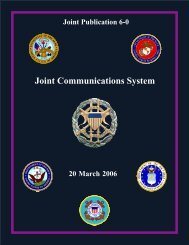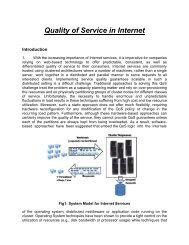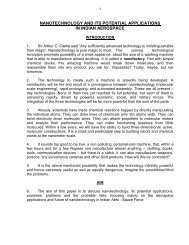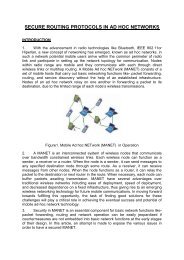Intrusion Detection Systems - Integrated Defence Staff
Intrusion Detection Systems - Integrated Defence Staff
Intrusion Detection Systems - Integrated Defence Staff
Create successful ePaper yourself
Turn your PDF publications into a flip-book with our unique Google optimized e-Paper software.
9interface to display filtering results as well as raw data. Shadow runs on manyUnix systems and Linux.Snort is a recent open-source public-domain effort to build a lightweight, efficient,ID tool that can be deployed on a wide variety of Unix platforms. According to theSnort Web site (www.snort.org), views are quickly outdated. The “Technology”sidebar describes a sample of commercial, research, and public domain tools.Snort is a lightweight network intrusion detection system, capable of performingreal-time traffic analysis and packet logging on IP networks. It can performprotocol analysis, content searching/ matching and can be used to detect a varietyof attacks and probes, such as buffer overflows, stealth port scans, CGI attacks,SMB probes, OS fingerprinting attempts, and much more. Snort uses a flexiblerules language to describe traffic that it should collect or pass, as well as adetection engine that utilizes a modular plugin architecture. Snort is currentlyundergoing rapid development. The user community is contributing auxiliary toolsfor analyzing and summarizing snort logs, providing additional capabilities. Moreimportantly, there is a large group of users who contribute new signatures. As aresult, new attacks are quickly represented in the signature database.Conclusion11. <strong>Intrusion</strong> detection systems (IDSs) attempt to identify computer system andnetwork intrusions and misuse by gathering and analyzing data. IDSs have traditionallybeen developed to detect intrusions and misuse for wired systems and networks. Morerecently, IDSs have been developed for use on wireless networks. These wireless IDSscan monitor and analyze user and system activities, recognize patterns of knownattacks, identify abnormal network activity, and detect policy violations for WLANs.Wireless IDSs gather all local wireless transmissions and generate alerts based eitheron predefined signatures or on anomalies in the traffic.12. <strong>Intrusion</strong> detection systems are an important addition to the security of wirelesslocal area networks. While there are drawbacks to implementing a IDS, the benefits willmost likely prove to outweigh the downsides. With the capability to detect probes, inaddition to assistance with policy enforcement, the benefits of a wireless IDS can besubstantial. Of course, just as with a wired network, an IDS is only one part of a greatersecurity solution wireless network. WLANs require a number of other securitymeasures to be employed before an adequate level of security can be reached, but theaddition of a wireless IDS can greatly improve the security posture of the entire network.With the immense rate of wireless adoption, the ever-increasing number of threats toWLANs, and the growing complexity of attacks, a system to identify and report on threatinformation can greatly enhance the security of a wireless network.
















